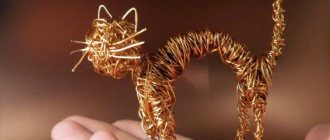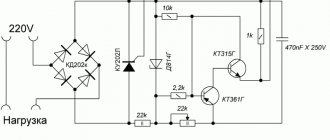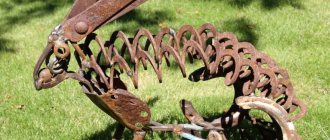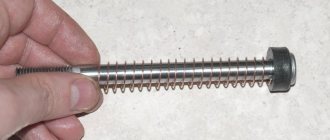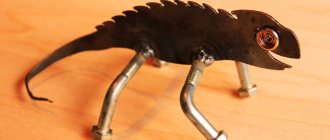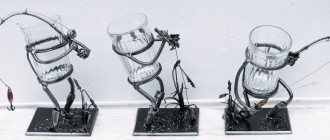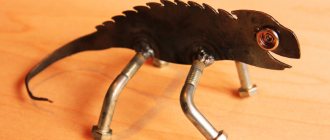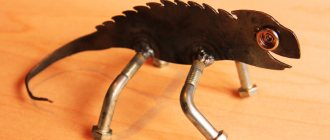Crafts that don't require special skills
Working with metal is difficult, but we have selected several options for products that can be completed with a minimum of effort. But imagination is still needed here.
Crafts made from thin sheet metal
If you purchase a thin sheet of metal, then work with sharp scissors. You don't need any additional equipment - you can make a figurine quite easily. We offer a product in the shape of an owl. To make it you will need to purchase:
- Sheet metal, narrow stripes.
- The backing is a wooden rectangular board no more than 0.5 cm thick.
- Nails fixing elements.
- Sharp scissors.
Sequence of work:
- It is necessary to draw a detailed sketch.
- Using a marker (preferably a permanent one), transfer the drawing from the sketch to a sheet of metal along the inside.
- Use sharp scissors to cut out the elements.
- Take a tool with which you can squeeze out bulges or draw grooves on the inside of the metal. A spoon with a rounded end handle will do.
- You can take additional elements, for example, buttons or plastic parts. They will serve as the eyes of a bird, or additional decorative elements decorating finished products.
- When the elements of the owl are cut out, you should begin to combine them into one finished product.
- Metal elements are fixed to the board using thin nails.
Crafts with your child
If there is a strip of thin metal, then working with it is quite simple. Therefore, it will be possible to involve the child in such manipulations.
It is very easy to make a snail from strip metal. To do this, you need to cut the required length of the tape. Then start wrapping it into a spiral.
The body is also made of sheet metal.
The main difficulty in this case will be in fixing the body and the spiral house. But here, too, ingenuity will come to the rescue. If it is not possible to fix it firmly, then you can use tape. This is especially true if the sheet of metal is quite thin and does not have significant weight.
You may wonder how aesthetically pleasing the shiny tape will look. Solving this problem is even easier - just take acrylic paints and paint the snail along with tape. It is the layer of polymer coating that will hide all the irregularities and additional materials used.
If it is impossible to work with tools, you should choose crafts that include finished metal products that should be combined with each other.
Laser technology
Laser technology is universal, as it makes it possible to process any metal alloys, because certain parameters are set on the machine for each metal.
The main feature of laser cutting is the absence of contact between the metal and the cutting device.
Laser cutting of material is carried out with a thin, focused light beam, due to which the metal sheet is heated and melted through.
The advantages of laser cutting are:
no deformation of the material;
the ability to cut complex contours;
no post-processing.
Equipment can be solid or gas. The solid-state tool is quite easy to operate and use.
The laser rod is made of neodymium glass, which has the ability to transmit a pulsed beam beam with a power of 6 kW.
The gas machine has a gas discharge tube instead of a glass rod.
The tube is filled with carbon dioxide, nitrogen, and helium. Electrical pulses activate gas molecules, which begin to emit energy that turns into a directed beam.
The power of some equipment models is 20 kW. Such equipment is expensive.
Laser technology for processing sheet metal makes it possible to form any complex shapes with a minimum of waste.
Thanks to the targeted beam effect, smooth and even edges without unevenness are obtained, which do not require additional processing.
An exception for laser processing is aluminum and aluminum alloys with stainless steel. Aluminum is difficult to laser cut due to its reflective properties.
Complex products requiring skill and additional tools
If you have a welding machine, then you can make metal crafts of any complexity. Nothing will limit your imagination even if you purchase metal scissors. A small hammer and anvil make the process even more creative and varied. In this case, nothing limits either the skill of the craftsman or the flight of his imagination. Any idea can be realized, even using scrap metal.
Flat original designs
If you want to make a homemade product that will decorate your garden plot, the facade of a house or a fence, you can make a flat image of any animal, flower or other object.
In this case, you will need sharp cutting tools with which you can cut out the desired image. The main part of the work will be creating a suitable sketch.
After an object of suitable size has been created on paper or thick cardboard, you need to transfer it to metal.
Then use a cutting tool to cut out not only the outline. But, internal perforation is desirable. It is the internal holes in the flat sculpture that will help recreate the image in the most naturalistic way and give it some lightness.
Using this method, you can create an original private house number plate. If you are not satisfied with the appearance of the metal, then you can decorate the product using paint of a suitable composition.
A teenager can be involved in such work as a master class, especially if he has a desire for applied work.
Three-dimensional sculpture
If you have sheet metal, you can make a three-dimensional sculpture to decorate the interior or garden area.
The design is similar to the previous product. The only difference is that here you need to cut out several elements that are attached at right angles.
The main point is to create a product that has a certain thickness. It can be different, depending on desire.
For a three-dimensional statue you need to make two identical blanks. And then the blanks for the end part, which will give volume to the entire structure.
When each element is cut out of metal, they must be combined into one whole. This is done by welding. But you will need to demonstrate certain skills and abilities. After all, a roughly made seam can ruin the appearance of the finished craft. True, if it was not possible to weld the structural elements too carefully, they can then be cleaned with a grinder. True, this will take some time and effort, so it is better to do everything more carefully right away.
Volumetric figure option
The use of flat sheet products, connected at right angles by insertion into grooves, allows you to create a three-dimensional model. The thickness of the groove must correspond to the thickness of the metal. Additional fastening is carried out by welding at the joints to impart rigidity to the structure.
Bending tools allow you to get away from linearity. Curved elements look more natural. The design takes on a naturalistic appearance. Coloring achieves diversity and the formation of a stylistic direction.
The fantasies of metal crafts are practically unlimited. You can get different variations from the photos below.
Plasma technology
Figured plasma cutting of sheet metal makes it possible to process material up to 10 cm thick with plasma.
Various coatings, rust, and dirt do not reduce the cutting quality. The operating principle is as follows: gas under pressure is supplied to the plasmatron nozzle.
Under the influence of electric pulses, the gas becomes plasma and an electric arc is formed between the cutting head and the steel sheet.
Cutting is carried out using a plasma jet. The basis of the method is a direct current direct current air-plasma arc.
During the plasma cutting process, the metal heats up to 30,000°.
The advantages of plasma cutting include:
high quality and clean cut;
absence of high temperature exposure leading to material deformation;
Compared to laser cutting, plasma technology is more productive, less expensive, and has a larger range of processed materials. Plasma can cut metal up to 150 mm thick.
The disadvantages of plasma cutting include the large cutting width, which can increase in proportion to the current strength of the plasma arc, as well as the taper of the edge, which is formed due to the shape of the plasma jet.
Plasma cutting is the most popular for cutting out shapes, as it combines the main criteria for price-quality ratio.
Cold forging
It includes two main methods of influencing metal: pressing and bending. The first is the impact action, leading to compaction of the top layer and mobility of the inner metal workpiece. The second is bending it along certain lines, creating waves, curls, spirals, zigzags.
Metal products created by cold forging are beautiful and easy to make if the craftsman has all the necessary equipment. The industry offers machines for cold forging, however, you can make them yourself, which will reduce the cost of the product.
The disadvantage of cold forging is the inability to correct mistakes. Such a workpiece will be considered damaged.
Art welding
A new movement that originated at the Institute named after E.O. Paton, brought technical welding to a new level - a fine art. This is no longer crude crafts made from scrap metal at a summer cottage, but a way to create masterpieces using welding.
Small life-size figurines of insects or animals, as well as gates, are all works of art welding.
To work at home using this technique you need:
- welding machine and consumables;
- iron blanks;
- inspiration and sleight of hand.
The main material is titanium, but craftsmen talk about the possibility of working with zirconium and stainless steel.
Tags: do it yourself
Comments 22
Here you can also place a bracket for adjusting the cutting depth with a fixed position, like on a generator, for example.
Sorry sir, I didn’t have time to shoot a video for you. In the description I think I wrote it in Russian, ask if anyone doesn’t understand anything
Everything is done well, with high quality. I am not criticizing in any way. I cut it easier. I press the 40x40 profile with a clamp as a guide ruler. On a small grinder I put a 125x1 disc, or even better, 125x0.8. I lean the flat of the disk against the side edge of the profile and immerse the disk into the metal a few mm. The cutting disc with its side surface does not grind off the metal and does not damage the guide. The cut turns out perfect.
Everything is done well, with high quality. I am not criticizing in any way. I cut it easier. I press the 40x40 profile with a clamp as a guide ruler. On a small grinder I put a 125x1 disc, or even better, 125x0.8. I lean the flat of the disk against the side edge of the profile and immerse the disk into the metal a few mm. The cutting disc with its side surface does not grind off the metal and does not damage the guide. The cut turns out perfect.
+1. I did the same. Cheap and cheerful. But then I got this.
It's a good thing, but the description is missing.
test! just for me since I’m afraid to hold an angle grinder in my hands
From the last photo everything became clear!
Not for the sake of criticism. Manufacturing complexity is lower.
I don’t understand how it works, why do you need an anchor?
This is an anchor from the earpiece. I did it at work, so as not to drag the whole machine - I removed the anchor
I don’t understand how it works, why do you need an anchor?
Well, about like a circular saw on wood.
It's expensive to cut iron with a grinder. One cut of a sheet 2mm in length is one disk per 230. If, of course, once a week, then it’s fine, but it’s easier to give it to where there is a guillotine. Or even buy something already cut from them. That's what I did. I found a large office, they bought metal at a discount, and the cut one from them came out cheaper than I would have bought it myself.
Agree. But I live in a small town, there are no offices for working with individuals. I also did non-mass cutting of metal for myself.
)This is a small ECB, almost one and a half million))) then, I actually live in a village))
I do not live in Yekaterinburg itself. And to go every time for a batch of metal... Don’t bother... And I don’t like it that way, I need everything to be my own
It's expensive to cut iron with a grinder. One cut of a sheet 2mm in length is one disk per 230. If, of course, once a week, then it’s fine, but it’s easier to give it to where there is a guillotine. Or even buy something already cut from them. That's what I did. I found a large office, they bought metal at a discount, and the cut one from them came out cheaper than I would have bought it myself.
It depends on what you cut... If you are making a roof or a fence, then yes, it is better to calculate everything and order metal to size from the seller. What if you are doing something narrowly focused? Clamps for example. Stainless steel mufflers... Something like this will do...
DIY roller knife for sheet metal
A do-it-yourself roller knife for sheet metal is a homemade tool, the demand for which is growing every day, which is explained by the productive speed of operation of such a device and its simple design. The mechanical basis is extremely simple, and is based on two metal knives rotating in opposite directions, pressing into the steel plane of the workpiece, which leads to its cutting.
The classic design involves the installation of rotating disks at the top and bottom, classified according to the material of manufacture:
- Parallel roller knives are used for cutting steel sheets into strips, while maintaining good quality of the workpiece.
- Roller knives with one inclined edge - this design, in addition to slicing, allows you to cut workpieces with rounded shapes.
- Roller knives with multiple inclined edges - maintaining a small radius, helps to produce parts with curved lines and rounded shapes.
Hot forging
Allows you to obtain a variety of items made of ductile metal. Heating imparts high plasticity to the material and the ability to shape it by force. A variety of hot forging methods create a range of products to suit every taste.
When choosing this technology, you need to consider:
- availability of a forge and provision of fire safety equipment;
- the final result depends on the properties of the metals; not all of them can be forged and welded;
- high cost of equipment and materials;
- influence of heating temperature on the properties of the workpiece.
Despite the disadvantages, the advantages of classical forging lie in the variety and beauty of the products.
